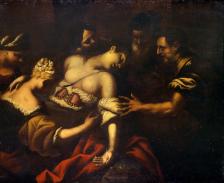The discovery of Cleopatra's body
The subject
This painting represents the death of the Egyptian queen Cleopatra in a rarely depicted iconographic version in which the essential element that caused the death of the queen, the asp, is not shown. Luca Giordano thus appears to have been inspired by the description of the story told by Plutarch who wrote simply that Cleopatra was found dead, dressed as a queen and accompanied by her handmaids, one of which was dying as well.
The painting
The circular composition of the work guides the focus towards the lifeless body of the queen who is supported by three handmaids and an unidentified character. The painter captured the moment when Mark Antony, told of the tragedy, discovered the body of his lifeless lover (even though historically Mark Antony appears to have killed himself before and not after Queen Cleopatra died). The expressive force of the latter is the “trademark” of Luca Giordano: the open hands, tense fingers, contracted forearm muscles and distraught expression were all elements of an established style that was unmistakably reflected in the Neapolitan master’s other works.
The personification of the queen is another helpful element to dating the work: in fact the curving forms of her bare breasts, elaborate drapery of her dress and chromatic richness indicate it was completed after Giordano’s early period which was marked by the instruction he received in Jusepe de Ribera’s workshop, and distinguished by airy brush strokes, an ascetic representation of flesh and dark colours. This piece, however, reveals an extensive knowledge of the Venetian school.
In fact, it is certain that the Neapolitan master spent a period of time in Laguna around the late 1650’s when he was a little over twenty years old. Following the canons of the Venetian school of art, the flesh here is imbued with curving and sensual forms while the other surfaces show bright colours. Being a classical subject, Giordano preferred to use the rich, full-bodied style of the Venetian school, which was much more suitable for the narrative function of such a theme than the more austere style of his first master, Ribera, which was more suited to religious ideas or depictions of virtue.







